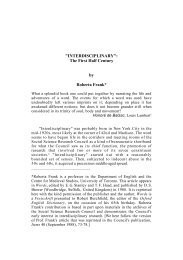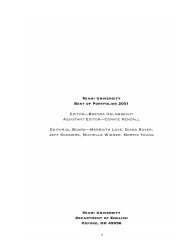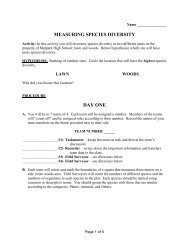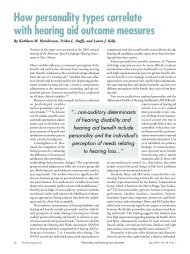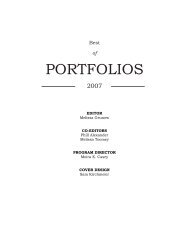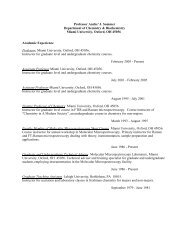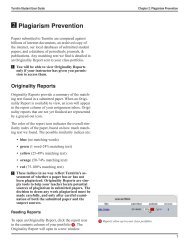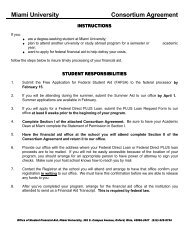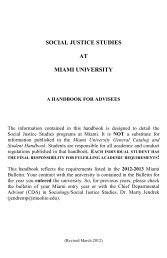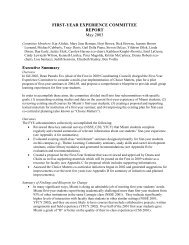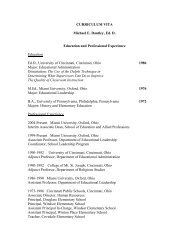Interdisciplinary Research Manual - Units.muohio.edu
Interdisciplinary Research Manual - Units.muohio.edu
Interdisciplinary Research Manual - Units.muohio.edu
Create successful ePaper yourself
Turn your PDF publications into a flip-book with our unique Google optimized e-Paper software.
49<br />
extent possible, you should develop that understanding, probe its implications (both for<br />
theory and for action), and apply it. When you reach the limits of what you can do<br />
yourself in this project, feel free to speculate on possible additional implications or<br />
identify potential applications. See if you can come up with recommendations for further<br />
development, implications, and applications, including suggestions of principles or<br />
proc<strong>edu</strong>res to follow and caveats regarding what to avoid in carrying out that additional<br />
work.<br />
After doing as much as time permits to improve the completeness and integration<br />
of your project, the next task is to insert, revise, or expand transitions. Check the flow of<br />
ideas throughout the project, adding transitions between paragraphs as needed. Since you<br />
wrote chapters separately and without full knowledge of the whole project of which they<br />
would become parts, pay particular attention to the beginning and end of each chapter.<br />
Are readers sufficiently apprised at the beginning of what is covered in the chapter? Have<br />
you explained, either at the beginning or end of each chapter, how it fits into the project<br />
as a whole? And have you provided transition at the end of each chapter, or<br />
foreshadowing within the chapter, so that readers can anticipate where you are headed in<br />
the next chapter? Then turn your attention to the sections of each chapter, making sure<br />
that there is sufficient transition, explicit or implicit, from one section to the next; as with<br />
chapters, readers should start each new section with some sense of why it’s there and how<br />
it relates to the section they just finished.<br />
If you discover that some of your paragraphs are too long (let’s say, more than<br />
two-thirds of a page long), then you need to make a conscious effort to balance length<br />
and coherence in breaking them into paragraphs of more appropriate length. Find a place<br />
to break up a too-long paragraph that gives both shorter paragraphs a different<br />
substantive focus while leaving them roughly comparable in length.<br />
The last task before handing in your project to be duplicated and bound is to<br />
prepare the pages that precede and follow the body of the project (see the next section of<br />
the <strong>Research</strong> <strong>Manual</strong> entitled “Outside the Body of the Project”). As you prepare those<br />
pages, remember that potential readers will form a first impression of the body of your<br />
project from the pages that precede it, much as you form first impressions of people you<br />
meet from the clothes they wear. It is pointless to sink months into producing a high<br />
quality project, only to turn away readers because of a sloppy abstract, for example. Your<br />
challenge is to persuade prospective readers, especially professionals for whom you were<br />
writing, to devote their scarce time to reading a lengthy undergraduate project. If the<br />
cover doesn’t catch their eye, if the title doesn’t draw them in, if the abstract and then the<br />
table of contents do not appear to reflect thorough scholarship and careful attention to<br />
detail, or if the preface is amateurish, then they will never find out how good the body of<br />
your project is because they will never read it. Dress your project as carefully as you<br />
would dress for a professional job interview. Before you turn it in to be duplicated and<br />
bound, carefully scrutinize its appearance one last time, much as you would check<br />
yourself in the mirror before walking into the interview.<br />
Outside the Body of the Project<br />
The Cover. When you turn your attention from the body of your project to the<br />
pages that surround it, you need to shift mental gears. You leave behind the challenge of<br />
making your argument credible to confront the challenge getting it read. You leave the



